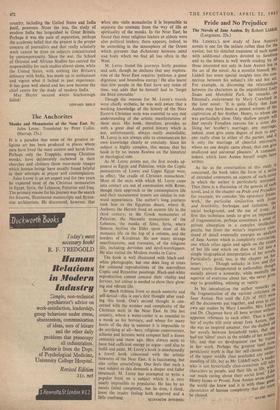The Anchorites
Monks and Monasteries of the Near East. By Jules Leroy. Translated by Peter Collin. (Harrap, 25s.)
IT is a paradox that some of the greatest re- ligious art has been produced in places where men have lived the most austere and harsh lives. Perhaps only the Trappists, among Christian monks, have deliberately eschewed in their churches and cloisters those man-made images which human beings have usually found helpful in their attempts at prayer and contemplation.
Jules Leroy is an art expert and for two years he explored most of the Christian monasteries in Egypt, Syria, the Lebanon, Palestine and Iraq. The primary reason for his journey was the search for frescoes, illuminated manuscripts and Byzan- tine architecture. He discovered, however, that
when one visits monasteries it is impossible to separate the contents from the way of life or
spirituality of the monks. In the Near East, he found that most religious leaders or abbots were also political leaders; there appears, indeed, to be something in the atmosphere of the Orient which prevents that dichotomy between mind and body which we find all too often in the West.
M. Leroy found his journeys fairly painless and safe, though he declares that any explora- tion of the Near East requires 'patience, a good digestion, and boundless energy.' He also learnt that few people in the East have any sense of time, and adds that he himself had to 'forget the fixed timetable.'
Though the reasons for M. Leroy's travels were chiefly esthetic, he was well aware that a
working knowledge of the history of the Near Eastern Christian sects was essential to any real understanding of the artistic manifestations of these sects. His book, therefore, provides us with a great deal of potted history which is not, unfortunately, always easily assimilable; M. Leroy is not always able to communicate his own knowledge clearly or concisely. Since his subject is highly complex, this means that his book is by no means flawless on the historical or theological side.
As M. Leroy points out, the first monks ap- peared in Egypt and Palestine, while the Coptic monasteries of Lower and Upper Egypt were, in effect, 'the cradle of Christian monachism.' Most of the sects with which M. Leroy came into contact are out of communion with Rome, though their approach to the contemplative life and their sacramental system are similar in out- ward appearances. The author's long journeys took him to the Egyptian desert, where St. Anthony the Hermit lived an austere life in the third century, to the Greek monasteries of Palestine, the Maronite monasteries of the Lebanon, the monks of Sinai, Syria, where Simeon Stylites the Elder spent most of his monastic life on the top of a column, and the borders of Kurdistan. He saw many strange manifestations, and travesties, of the religious life, including dervishes and devil-worshippers. He also visited the Moslem monks in Cairo.
The book is well illustrated with black-and- white photographs, but one does long at times for coloured reproductions of the marvellous Coptic and Byzantine paintings. Black-and-white reproduction cannot conceal their vitality and fervour, but colour is needed to show their glow- ing and vibrant life.
So much richness from so much austerity and self-denial—this is one's first thought after read- ing this book. One's second thought is con- cerned with the number and complexity of the Christian sects in the Near East. In this hot country, where a water-cooler is as essential to a monk as his breviary, and where for many hours of the day in summer it is impossible to do anything at all—here, religious controversies, schisms and heresies were rampant half a dozen centuries and more ago. Men always seem to have had sufficient energy to argue—and also to build and paint. M. Leroy's book is unashamedly a travel book concerned with the artistic treasures of the Near East. It is fascinating, but also rather unsatisfying. One feels that such a vast subject as this demands a deeper and fuller treatment. M. Leroy has attempted to write a popular book on a subject which it is very nearly impossible to popularise. He has by no means failed completely, but he does, I think, leave the reader feeling both deprived and a little confused. ELIZABETH JENNINGS


































 Previous page
Previous page